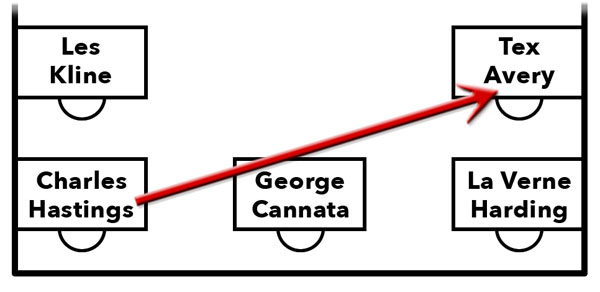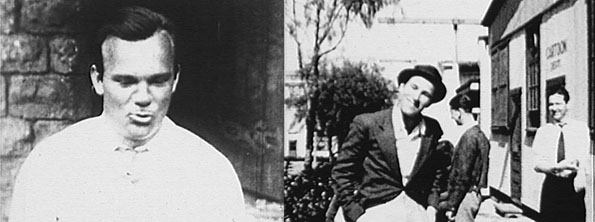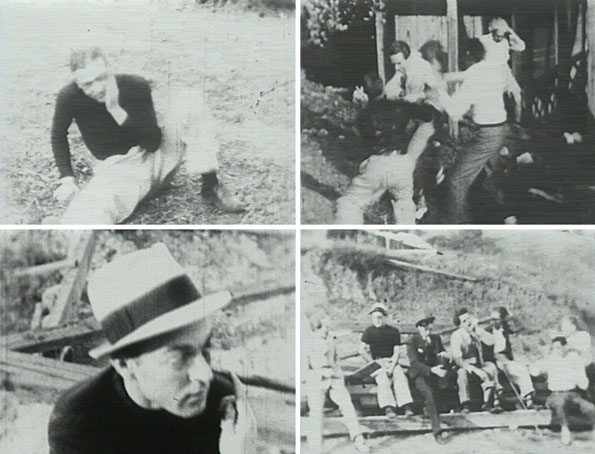This was a gruesome incident that gets whispered about in the annals of Golden Age animation, so perhaps it is time to point a forensic lens at that devastating paperclip that Charles Hastings shot at Tex Avery in 1933. Whether or not his subsequent loss of depth perception contributed to a flat stylization in Avery cartoons can certainly be debated, but it does seem only human to rationalize or give meaning to something that was regrettable and unfortunate.
This was the first of a number of setbacks that Tex endured in his life, providing a tragic counterpoint to his legendary reputation as a gagman and a comedy innovator. It may also have been something of an impetus for change, spurring him on to new milestones and achievements. A look at a seating chart from the Universal Cartoon Department at that time gives some insight into this event.

From the chart, based on information provided to me by Ed Benedict, it seems that Hastings worked slightly behind Avery, across and to his left. It was a studio routine to fire spitballs at those workers in front, making Hasting’s seat in the back corner rather favorable. For a look at the full room chart from 1933, see my previous Walter Lantz Archive post.
Based on some period photos, each animation desk along the side walls is believed to have had a hutch with shelving on it, so lines of fire were probably afforded across the room at angles, not directly forward. George Cannata’s desk, which appears on the seating chart next to Hastings against the back wall, must not have obstructed the shot at Avery.
 Charles Hastings was seated at his desk when he fired the paperclip, based on an account by Fred Kopietz in an interview with Michael Barrier, though this interview disputes some of the information that Benedict provided to me. Kopietz said, “[Hastings] was at the desk right in front of me, if I recall. Tex was over here, to my left, against the other wall. Charlie called, ‘Hey, Tex,’ or did something, and snapped one of these clips, a regular oval clip, with a rubber band, and caught Tex right in the eye.”
Charles Hastings was seated at his desk when he fired the paperclip, based on an account by Fred Kopietz in an interview with Michael Barrier, though this interview disputes some of the information that Benedict provided to me. Kopietz said, “[Hastings] was at the desk right in front of me, if I recall. Tex was over here, to my left, against the other wall. Charlie called, ‘Hey, Tex,’ or did something, and snapped one of these clips, a regular oval clip, with a rubber band, and caught Tex right in the eye.”
According to Benedict, Kopietz was in front of Avery, not Hastings, but these two accounts both verify that the men were seated on opposite sides of the room, regardless of where Kopietz was seated. Barrier’s interview was from 1991 and my interview with Benedict was from 1995, so we must be mindful that both recollections are roughly six decades removed from the event.
There was bitterness from fellow animators toward Hastings for his cruel prank, as would be normal in the aftermath of an incident like this. From Joe Adamson’s Tex Avery: King of Cartoons book interview, Tex described Hastings as someone who was “really a bit off” and “had actually been kicked in the head by a horse; had a huge scar across his forehead.”
A heart-rending irony is that Avery was a key figure in the escalation of the pranks at Universal. I’ll deal with those in future posts, but let’s just say that that he was hardly one to have constrained his own behavior on account of decency or safety. Avery once put horse-shit inside Manuel Moreno’s desk and also stole a movie-prop dummy—pulling a gray sweatshirt on it—to make it seem like Bill Nolan had collapsed or died.
The culture of pranks that he so vigorously stoked had a seemingly karmic effect. Hastings traded up from spitballs to a wire paperclip. By Avery’s account, “One of the boys yelled, ‘Look out, Tex!’ and I turned and caught the clip in my left eye. That lost me one eye in a split second.”
 One of the details that is misleading from this account is that he was figuratively stating he lost the eye “in a split second.” By this, he refers to the shot that struck him so suddenly, not the onset of blindness. With cases of ocular injury, the initial effect is often redness, swelling and pain from a laceration or corneal abrasion.
One of the details that is misleading from this account is that he was figuratively stating he lost the eye “in a split second.” By this, he refers to the shot that struck him so suddenly, not the onset of blindness. With cases of ocular injury, the initial effect is often redness, swelling and pain from a laceration or corneal abrasion.
His vision may have immediately blurred, but it’s also human instinct to keep the damaged eye closed, moistened and protected by the eyelid. The key to recovery from this type of injury is proper medical treatment. The long-term result can be dictated, for better or for worse, by the type of care that is administered in the days or even weeks that follow.
When the treatment is poor or neglectful, the condition of the eye may deteriorate slowly over time. In short, the injury causes further irritation and decline. To my knowledge, there are no accounts of what Tex did to treat himself. We do know, however, that the pressures to meet footage counts at the studio could be burdensome and that medical leaves at that time might have had ominous professional consequences.
The Universal animators kept long hours, working hard and playing hard, but there was surely a dark side to the levity of all that outrageous horseplay. The pranks were probably stress releases. Considering Avery’s ambitions, and the fact that Bill Nolan was delegating work to him in 1933, he might well have been dismissive of properly caring for his eye to ensure that his rising status did not slip back among his peers.
Naturally there are reasons to expect that ophthalmic care from over 80 years ago just wasn’t adequate to deal with the injury, but the slow degeneration of his eye makes this theory at least seem plausible. It is easy to imagine the hard-charging Tex refusing to yield to weakness, a workaholic animator in denial of his worsening medical crisis until it was too late.

Tex Avery (left) and Ed Benedict (right) in frames from a rare home movie taken during Avery’s Lantz years.
According to Benedict, after a period of 3 or 4 months, Tex Avery had lost all vision in that left eye. This surely was a formative moment in his career, and there have been no shortages of psychological and artistic interpretations about its effect that people have offered over the years. Yet on the heels of that incident Avery certainly did not retreat or appear vulnerable. Instead, with one good eye, he boldly charted his own course, leaving Universal behind to lead the famed “Termite Terrace” unit at Schlesinger.
As cartoon anecdotes go, this one has achieved a kind of mythic status. Oswald the Lucky Rabbit was a ruthless harbinger of change for a number of careers, including the kick in the pants that Walt Disney needed to form a new studio around Mickey, so this paperclip shot across the room at Tex is just dripping with symbolism. More than likely, at that moment, he was sitting there at his desk drawing Oswald.
Martha Goldman Sigall, who worked with Avery at Warner and MGM, told me that Avery ultimately needed surgery to have the left eye completely removed. She said that he wore a glass eye and according to Martha “you could hardly tell it was fake.”
Tex Avery was mostly quiet on the topic. In all the decades of his career that followed, one didn’t talk about the eye. So you can gather what you will from this quote, the only reflection that Tex himself offers about it within the Adamson interviews: “While I was at Lantz’s, in the early thirties, an incident occurred that made me feel the animation business owed me a living.”
FOOTNOTE: The exact timing of this incident is not generally documented, but I place it at 1933 because I own a rare ‘home-movie’ made by the Universal animators during that same year. Within this film, Avery’s eye has not yet been injured, and by the end of the year Hastings had left the studio, providing a timeframe in which to pinpoint this incident. The photos shown above are all frame-captured from my 16mm film print. Above, see Tex Avery seated and Ed Benedict standing in front of the Cartoon Dept. Below: The four-image block shows the stages of an eerily prescient enactment of a big fight among the Universal animators on the studio backlot, culminating in a painted-on bruised left eye and various faked injuries.



 Tom Klein is a Professor and the Chair of the Animation program at Loyola Marymount University, in Los Angeles. He has been published internationally and has been profiled in The New York Times for his work as a scholar of the Walter Lantz studio. He has worked at Vivendi-Universal Games and Universal Cartoon Studios. Follow him @VizLogic
Tom Klein is a Professor and the Chair of the Animation program at Loyola Marymount University, in Los Angeles. He has been published internationally and has been profiled in The New York Times for his work as a scholar of the Walter Lantz studio. He has worked at Vivendi-Universal Games and Universal Cartoon Studios. Follow him @VizLogic



















































I heard the story a different way, but I can’t recall the source. I heard the animators had a target on door that they were throwing paperclips at and Tex walked through the door and got caught in the eye. My impression was that it was an accident rather than a malicious prank. Jeff Massie of the Animation Guild might be able to point you to who started the version I heard. Dallas McKennon, who worked with Tex at Lantz in the 50’s might have relayed the story to me.
Gene, I’ve heard these alternate versions like you’ve heard, including one where it’s a pushpin not a paperclip. That’s why I consider the story “legendary” because it’s widely repeated, not often accurately. And since it’s sort of unseemly to be written about in detail in formal histories of animation (too sensationalist and morbid I suppose) there haven’t been many trusted sources to help verify fact from urban legend. Certainly I don’t trust some of those “heard it from a guy” stories, and even what Dal heard in the 50s would likely be subject to this. Based on the direct accounts of Kopietz, Benedict and even Avery, it just doesn’t seem like Tex was walking through a door and suddenly got in the way. Their stories seem to match: someone called to Tex Avery (suggesting he was stationary, at his desk) and he turned his head just as the paperclip was shot at him. I do think that Hastings intentionally aimed, but as we know with these types of pranks, he did not realize how horrible the consequence would be.
Is Tex Avery the only animation filmmaker to lose a single eye?
I don’t believe it was a result of horseplay, but the Warner Bros. animator Lloyd Vaughan was blind in one eye too.
George Cannata could have reached out and intercepted that clip. Minor hand injury at worst. Damn him.
The ‘Magic Paperclip’ Theory